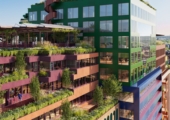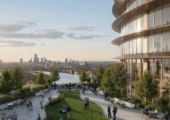April 2, 2025
Office fit out costs rise as firms adapt to new ways of working
 According to a new report from JLL, the office sector is again taking ‘centre stage’ in commercial real estate as companies worldwide adapt hybrid work policies to encourage greater in-office attendance. However, this renewed focus on office spaces comes at a cost, with businesses facing rising expenses to design and fit out their work environments. According to JLL’s newly released Global Office Fit-Out Costs Guide 2025, 59 percent of organisations globally plan to increase investment in office space design and fit-outs over the next five years. The report, which analyses data from 68 cities across 40 countries, highlights significant cost variations, key cost drivers, and the growing demand for sustainable office spaces.
According to a new report from JLL, the office sector is again taking ‘centre stage’ in commercial real estate as companies worldwide adapt hybrid work policies to encourage greater in-office attendance. However, this renewed focus on office spaces comes at a cost, with businesses facing rising expenses to design and fit out their work environments. According to JLL’s newly released Global Office Fit-Out Costs Guide 2025, 59 percent of organisations globally plan to increase investment in office space design and fit-outs over the next five years. The report, which analyses data from 68 cities across 40 countries, highlights significant cost variations, key cost drivers, and the growing demand for sustainable office spaces.
Across all regions, the cost of office fit-outs has increased over the past year, albeit to varying degrees. North America leads the way, with average fit-out costs reaching $3,070 per square metre—significantly higher than the global average of $1,830 per square metre. Latin America follows with an average cost of $1,790, while Europe, the Middle East, and Africa collectively see an average of $1,970. The Asia-Pacific region reports the lowest costs, averaging $1,460 per square metre.
JLL’s findings show that the most expensive cities for office fit-outs continue to include major hubs such as London, Tokyo, Vancouver, Dubai, and several key US cities. Conversely, markets with high construction growth, such as India, South Africa, Vietnam, and China, offer some of the lowest fit-out costs globally, though prices in these regions are evolving as demand rises.
The rise in office fit-out costs is largely driven by inflation, increased material costs, and currency fluctuations. JLL’s research indicates that three-quarters of markets have experienced raw material price hikes, while half report labour shortages contributing to higher construction costs.
Companies planning office upgrades must account for these factors in their budgets. JLL’s nine-point pricing matrix, which categorises costs based on quality levels and office configurations, provides guidance for businesses navigating these financial challenges. Construction work remains the largest component of fit-out expenses, accounting for 37 percent of total costs globally, followed by mechanical and electrical (M&E) services, which vary between 20 and 45 percent depending on the region.
Sustainability is also becoming a key factor in office design. JLL’s research found that 60 percent of surveyed markets have seen an increase in client demand for environmentally friendly office spaces. The company’s recent Future of Work study suggests that two-thirds of organisations plan to ramp up their investments in sustainability over the next five years.
Sustainable office fit-outs often involve significant upfront costs, with M&E services representing an average of 29 percent of total expenses, and in some cases, up to 50 percent. However, these investments can yield substantial long-term savings, with potential reductions of 10 to 40 percent in operational energy costs depending on the level of investment.
To ensure cost-effective sustainability initiatives, JLL advises companies to integrate energy-efficient components early in the project planning process. This proactive approach can help businesses avoid last-minute additions and unexpected expenses.
Despite the positive momentum in the office sector, challenges remain. Labour shortages, talent acquisition, material availability, and economic uncertainties continue to impact office fit-out projects worldwide. Additionally, geopolitical instability and trade policy changes are introducing new risks into the planning process.
Ruth Hynes, Director of Research & Strategy for JLL Work Dynamics EMEA, acknowledges the complexities of the current market. “The global office sector faces a challenging yet promising landscape in 2025. As corporate clients expand their footprints, we anticipate continued activity in office construction despite market uncertainty. Strategic early planning will be key to the success of office fit-out initiatives.”















